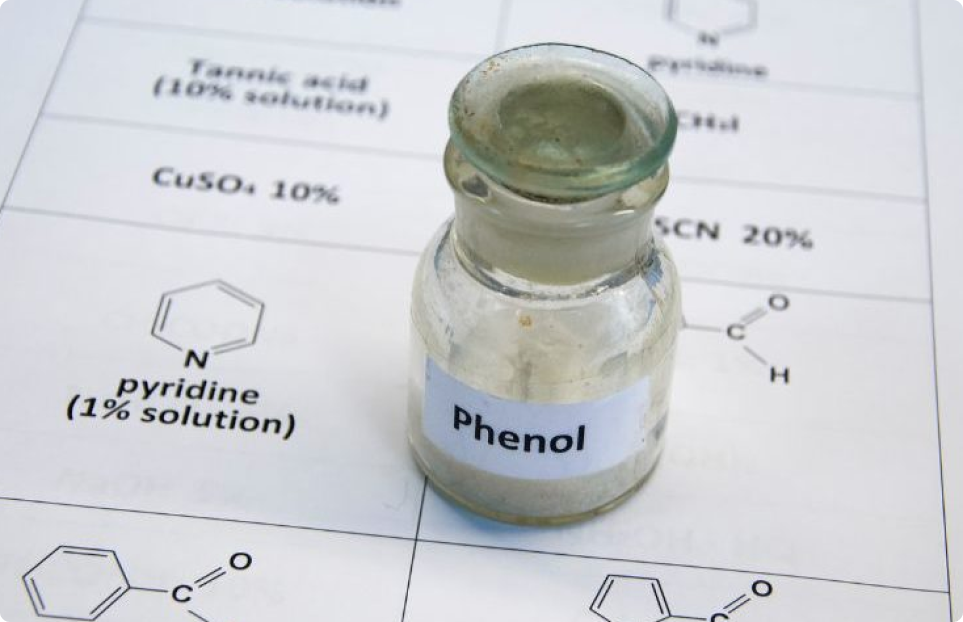
June 26, 2024
Phenol: The Chemical Behind Many Modern Products
Phenol, a simple molecule with the formula C₆H₅OH, plays a surprisingly vast role in our modern world. Beyond its association with carbolic soap, phenol serves as a fundamental building block for a multitude of products we encounter daily. This blog delves into the diverse applications of phenol, exploring its presence in plastics, resins, and a surprising array of materials that shape our lives.
Fundamental characteristics of phenol
Phenol is a crystalline solid with a sweet, medicinal odor. While sparingly soluble in water, phenol readily dissolves in organic solvents like ethanol and chloroform. Phenols generally have higher boiling points compared to other hydrocarbons. Phenols are more acidic than alcohols.
Phenol is majorly produced by the cumene Process. In traditional cumene process it involves benzene reacts with propene to form cumene. Then after Air is bubbled through the cumene, causing it to react with oxygen to form cumene hydroperoxide. At last cumene hydroperoxide is treated with acid to cleave the molecule, producing phenol and acetone. Due to various drawbacks there are some emerging methods are developed to encounter the drawbacks of cumene process.
Emerging Phenol Production Technologies
Direct Oxidation of Benzene: One promising approach is the direct oxidation of benzene to phenol, bypassing the cumene intermediate. This method aims to use oxidants like nitrous oxide, hydrogen peroxide, or oxygen to convert benzene directly to phenol. However, the challenge lies in developing cost-effective and efficient oxidation processes.
Oxidation of Toluene or Cyclohexylbenzene: Other routes involve the oxidation of toluene or cyclohexylbenzene using copper-catalyzed or autoxidation reactions to produce phenol. While these methods have been explored, they have not yet seen widespread adoption compared to the cumene process.
Hydrolysis of Benzene Derivatives: Historical methods like the hydrolysis of benzenesulfonic acid or chlorobenzene have been used to produce phenol, but they often require the disposal of problematic byproducts.
Major use of Phenol in Plastics and Resins:
Phenol’s true strength lies in its ability to form the foundation of essential resins and plastics. Here’s how it is useful in plastics and resins.
Phenolic Resins: When phenol reacts with formaldehyde, it creates a category of thermosetting resins known as phenolics. These versatile resins find application in various industries:
Construction: Phenolic resins act as binding agents in plywood, oriented strand board (OSB), and laminates used for countertops and flooring. Their heat resistance makes them ideal for these applications.
Automotive: Phenolic resins find use in brake linings and clutch facings due to their high strength and heat resistance.
Appliances: Phenolic resins provide excellent electrical insulation properties, making them crucial components in circuit boards and appliance housings.
Nylon Intermediates: Phenol plays a pivotal role in the production of nylon precursors like caprolactam and adipic acid. These intermediates are then polymerized to form various types of nylon used in textiles, carpets, and engineering applications.
Beyond the Basics: Niche Markets and Emerging Applications
Pharmaceuticals: Phenol serves as a starting material for the synthesis of numerous vital medications, including aspirin, a pain reliever, and salicylic acid, a key ingredient in acne treatments. Additionally, some phenol derivatives possess antiseptic properties, making them valuable disinfectants.
Explosives: Certain phenol derivatives, like picric acid, were historically used in explosives. However, due to their high sensitivity, safer alternatives are now favored.
Advanced Materials: Research is exploring the potential of phenol-based materials in the development of lightweight composites for aerospace applications and fire-resistant polymers for construction purposes.
Dyes and Indicators: Phenol and its derivatives play a role in the production of synthetic dyes used in textiles and industries. Additionally, some phenol derivatives act as pH indicators, crucial for scientific experiments.
Exploring New Frontiers: The Future of Phenol Applications
Bio-based Phenol: Traditional production methods rely on petroleum derivatives. However, research is actively exploring the development of bio-based phenol derived from renewable resources like cellulose or lignin. This approach offers a more sustainable alternative for the future.
Safer Derivatives: Scientists are continually developing new phenol derivatives with minimized health risks while maintaining their desired functionalities. This ensures the continued use of phenol in various applications with a reduced risk of adverse effects.
The Balancing Act: Benefits and Risks of Phenol
While phenol offers a multitude of benefits, it’s crucial to acknowledge its potential risks:
Health Concerns: Phenol can cause skin irritation and respiratory problems with prolonged exposure. Proper handling procedures and safety measures are essential when working with phenol.
Environmental Impact: Traditional production methods for phenol can have environmental consequences. The shift towards bio-based production and responsible waste management practices are crucial for mitigating these impacts.
Conclusion: Phenol – A Cornerstone of Modernity
Phenol, a seemingly simple molecule, stands as a testament to human ingenuity. From essential plastics and resins to life-saving medications, phenol’s diverse applications impact our lives in countless ways. As we move forward, the focus lies on developing safer alternatives, exploring bio-based production methods, and ensuring responsible use and disposal of phenol to minimize environmental impact. Phenol’s story is far from over, and its future holds promise for continued innovation and advancements in various fields.


